Marketing Strategy for the Nissan LEAF Electric Vehicle Report
VerifiedAdded on 2020/05/28
|9
|1847
|1227
Report
AI Summary
This report provides a comprehensive marketing strategy analysis for the Nissan LEAF electric vehicle. It begins with an external market analysis, identifying competitors and challenges such as consumer perception and charging infrastructure. The internal market analysis highlights the company's vision for electric vehicles and the features of the LEAF. The report then details the target market, including environmentally conscious consumers, women, and corporate buyers. A positioning strategy is outlined, emphasizing the LEAF's green credentials, economic benefits, convenience, ease of use, and warranty. The product and pricing strategy, channel strategy, and communication strategy are also discussed, including the use of dealers, word-of-mouth marketing, and various advertising channels. The report concludes by summarizing the key elements of the marketing plan and its potential for success.
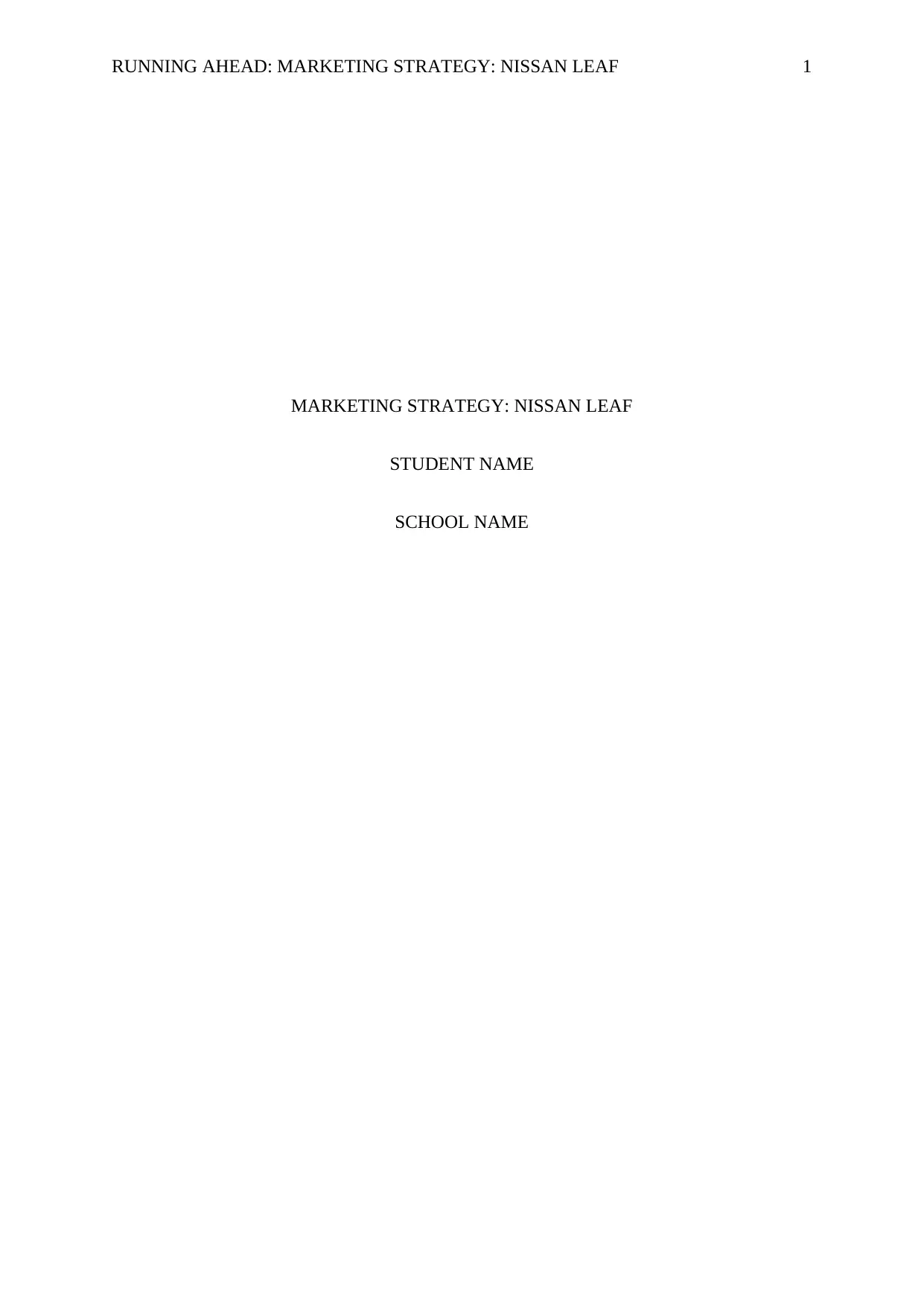
RUNNING AHEAD: MARKETING STRATEGY: NISSAN LEAF 1
MARKETING STRATEGY: NISSAN LEAF
STUDENT NAME
SCHOOL NAME
MARKETING STRATEGY: NISSAN LEAF
STUDENT NAME
SCHOOL NAME
Paraphrase This Document
Need a fresh take? Get an instant paraphrase of this document with our AI Paraphraser
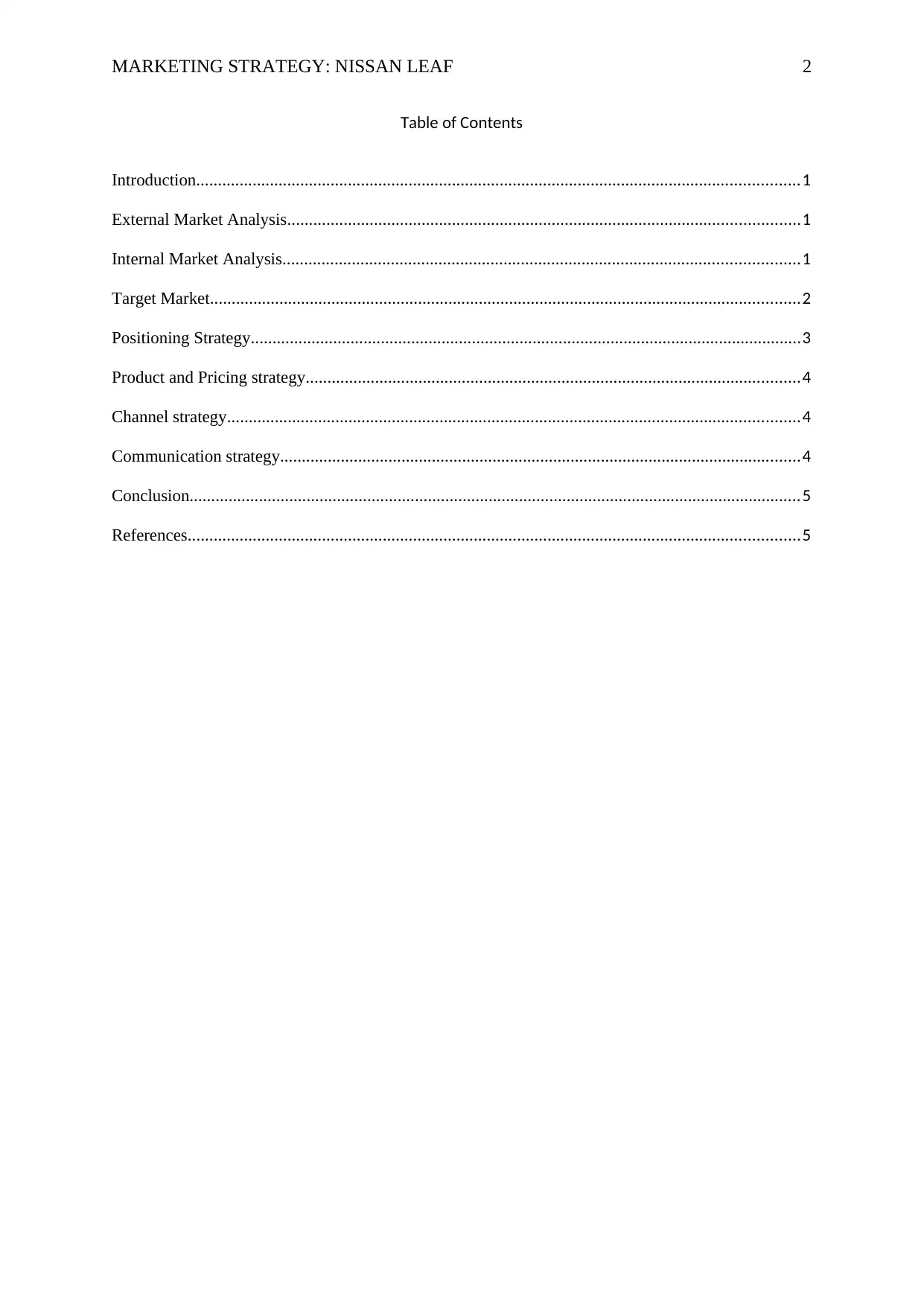
MARKETING STRATEGY: NISSAN LEAF 2
Table of Contents
Introduction...........................................................................................................................................1
External Market Analysis......................................................................................................................1
Internal Market Analysis.......................................................................................................................1
Target Market........................................................................................................................................2
Positioning Strategy...............................................................................................................................3
Product and Pricing strategy..................................................................................................................4
Channel strategy....................................................................................................................................4
Communication strategy........................................................................................................................4
Conclusion.............................................................................................................................................5
References.............................................................................................................................................5
Table of Contents
Introduction...........................................................................................................................................1
External Market Analysis......................................................................................................................1
Internal Market Analysis.......................................................................................................................1
Target Market........................................................................................................................................2
Positioning Strategy...............................................................................................................................3
Product and Pricing strategy..................................................................................................................4
Channel strategy....................................................................................................................................4
Communication strategy........................................................................................................................4
Conclusion.............................................................................................................................................5
References.............................................................................................................................................5
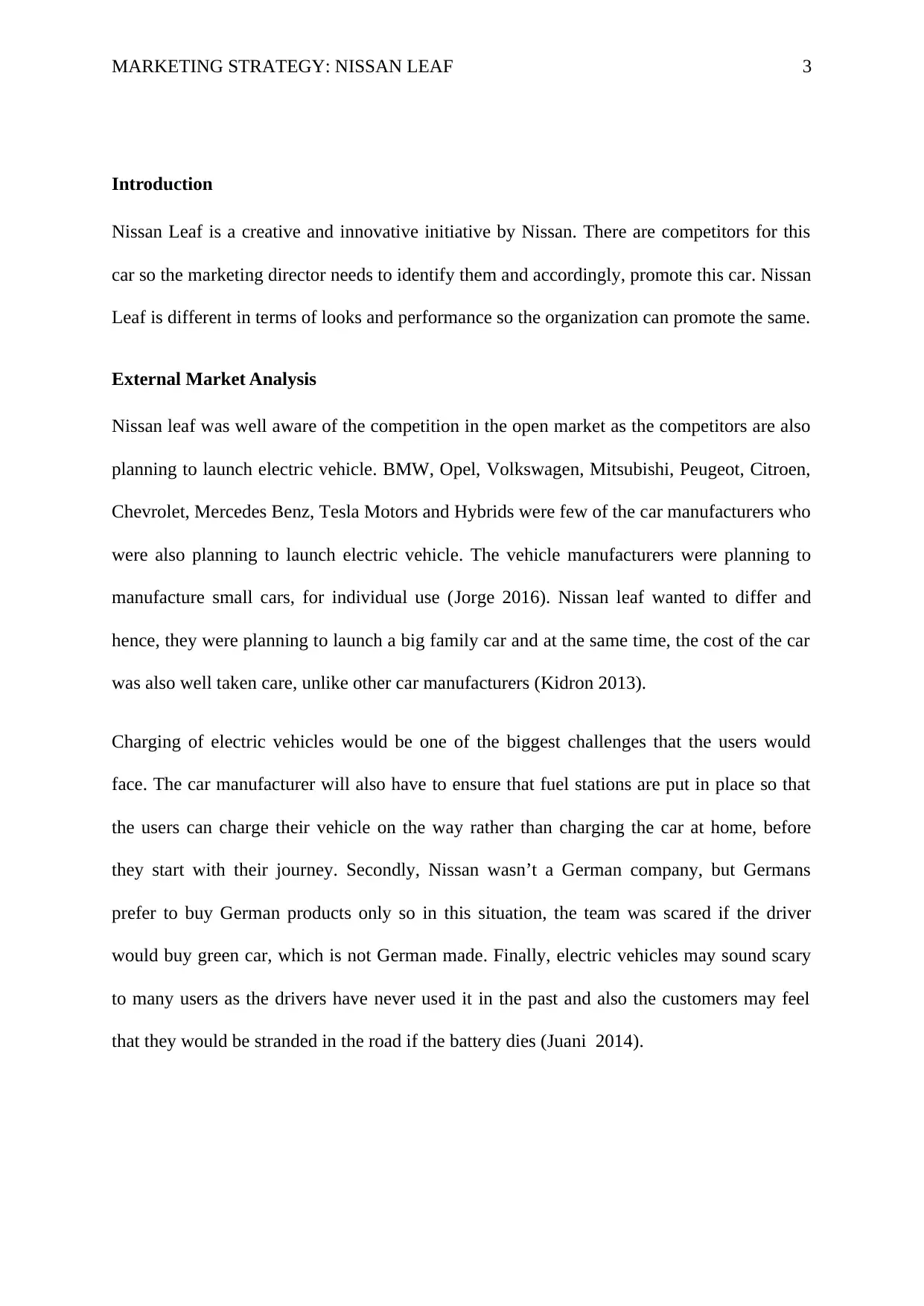
MARKETING STRATEGY: NISSAN LEAF 3
Introduction
Nissan Leaf is a creative and innovative initiative by Nissan. There are competitors for this
car so the marketing director needs to identify them and accordingly, promote this car. Nissan
Leaf is different in terms of looks and performance so the organization can promote the same.
External Market Analysis
Nissan leaf was well aware of the competition in the open market as the competitors are also
planning to launch electric vehicle. BMW, Opel, Volkswagen, Mitsubishi, Peugeot, Citroen,
Chevrolet, Mercedes Benz, Tesla Motors and Hybrids were few of the car manufacturers who
were also planning to launch electric vehicle. The vehicle manufacturers were planning to
manufacture small cars, for individual use (Jorge 2016). Nissan leaf wanted to differ and
hence, they were planning to launch a big family car and at the same time, the cost of the car
was also well taken care, unlike other car manufacturers (Kidron 2013).
Charging of electric vehicles would be one of the biggest challenges that the users would
face. The car manufacturer will also have to ensure that fuel stations are put in place so that
the users can charge their vehicle on the way rather than charging the car at home, before
they start with their journey. Secondly, Nissan wasn’t a German company, but Germans
prefer to buy German products only so in this situation, the team was scared if the driver
would buy green car, which is not German made. Finally, electric vehicles may sound scary
to many users as the drivers have never used it in the past and also the customers may feel
that they would be stranded in the road if the battery dies (Juani 2014).
Introduction
Nissan Leaf is a creative and innovative initiative by Nissan. There are competitors for this
car so the marketing director needs to identify them and accordingly, promote this car. Nissan
Leaf is different in terms of looks and performance so the organization can promote the same.
External Market Analysis
Nissan leaf was well aware of the competition in the open market as the competitors are also
planning to launch electric vehicle. BMW, Opel, Volkswagen, Mitsubishi, Peugeot, Citroen,
Chevrolet, Mercedes Benz, Tesla Motors and Hybrids were few of the car manufacturers who
were also planning to launch electric vehicle. The vehicle manufacturers were planning to
manufacture small cars, for individual use (Jorge 2016). Nissan leaf wanted to differ and
hence, they were planning to launch a big family car and at the same time, the cost of the car
was also well taken care, unlike other car manufacturers (Kidron 2013).
Charging of electric vehicles would be one of the biggest challenges that the users would
face. The car manufacturer will also have to ensure that fuel stations are put in place so that
the users can charge their vehicle on the way rather than charging the car at home, before
they start with their journey. Secondly, Nissan wasn’t a German company, but Germans
prefer to buy German products only so in this situation, the team was scared if the driver
would buy green car, which is not German made. Finally, electric vehicles may sound scary
to many users as the drivers have never used it in the past and also the customers may feel
that they would be stranded in the road if the battery dies (Juani 2014).
⊘ This is a preview!⊘
Do you want full access?
Subscribe today to unlock all pages.

Trusted by 1+ million students worldwide
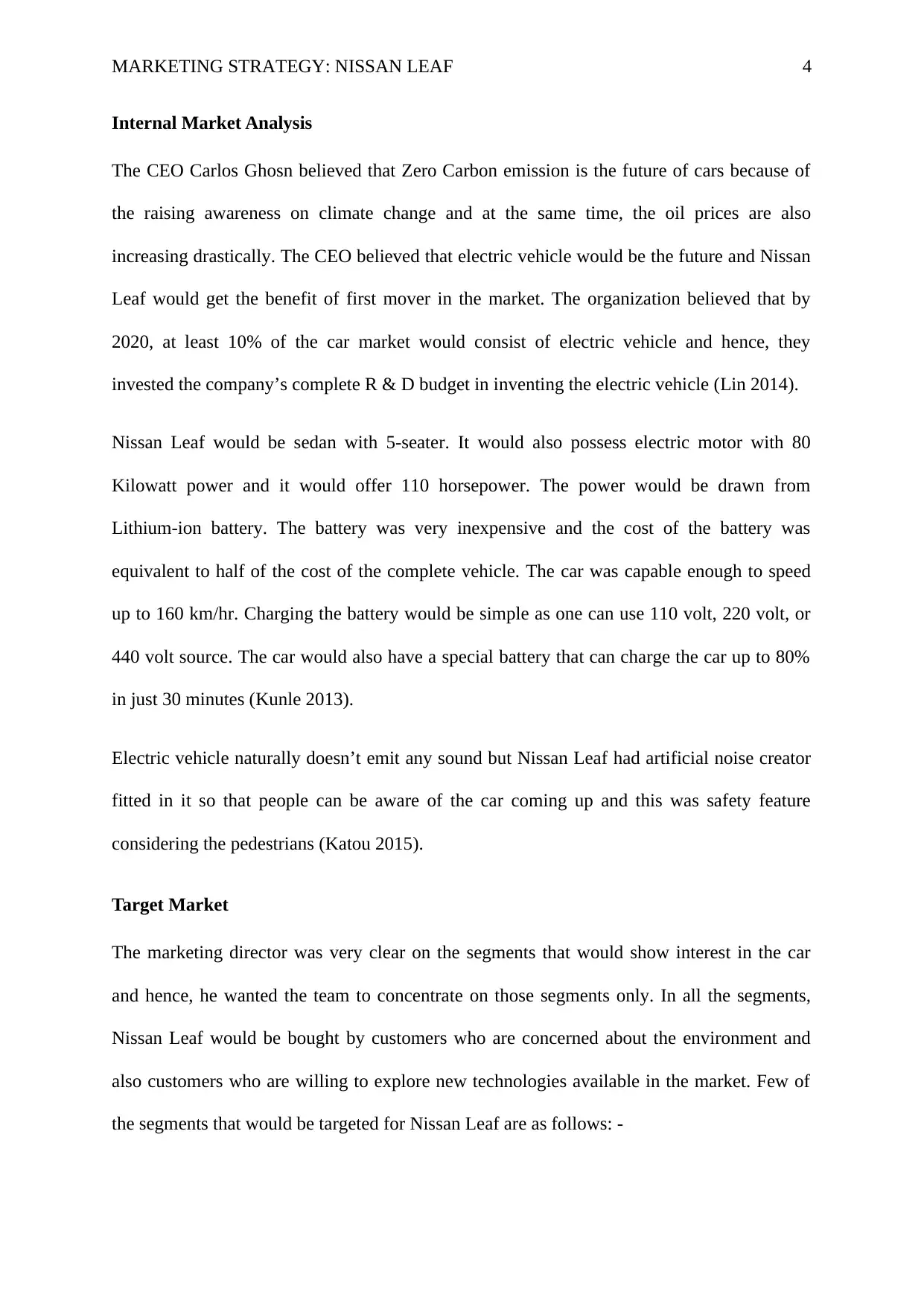
MARKETING STRATEGY: NISSAN LEAF 4
Internal Market Analysis
The CEO Carlos Ghosn believed that Zero Carbon emission is the future of cars because of
the raising awareness on climate change and at the same time, the oil prices are also
increasing drastically. The CEO believed that electric vehicle would be the future and Nissan
Leaf would get the benefit of first mover in the market. The organization believed that by
2020, at least 10% of the car market would consist of electric vehicle and hence, they
invested the company’s complete R & D budget in inventing the electric vehicle (Lin 2014).
Nissan Leaf would be sedan with 5-seater. It would also possess electric motor with 80
Kilowatt power and it would offer 110 horsepower. The power would be drawn from
Lithium-ion battery. The battery was very inexpensive and the cost of the battery was
equivalent to half of the cost of the complete vehicle. The car was capable enough to speed
up to 160 km/hr. Charging the battery would be simple as one can use 110 volt, 220 volt, or
440 volt source. The car would also have a special battery that can charge the car up to 80%
in just 30 minutes (Kunle 2013).
Electric vehicle naturally doesn’t emit any sound but Nissan Leaf had artificial noise creator
fitted in it so that people can be aware of the car coming up and this was safety feature
considering the pedestrians (Katou 2015).
Target Market
The marketing director was very clear on the segments that would show interest in the car
and hence, he wanted the team to concentrate on those segments only. In all the segments,
Nissan Leaf would be bought by customers who are concerned about the environment and
also customers who are willing to explore new technologies available in the market. Few of
the segments that would be targeted for Nissan Leaf are as follows: -
Internal Market Analysis
The CEO Carlos Ghosn believed that Zero Carbon emission is the future of cars because of
the raising awareness on climate change and at the same time, the oil prices are also
increasing drastically. The CEO believed that electric vehicle would be the future and Nissan
Leaf would get the benefit of first mover in the market. The organization believed that by
2020, at least 10% of the car market would consist of electric vehicle and hence, they
invested the company’s complete R & D budget in inventing the electric vehicle (Lin 2014).
Nissan Leaf would be sedan with 5-seater. It would also possess electric motor with 80
Kilowatt power and it would offer 110 horsepower. The power would be drawn from
Lithium-ion battery. The battery was very inexpensive and the cost of the battery was
equivalent to half of the cost of the complete vehicle. The car was capable enough to speed
up to 160 km/hr. Charging the battery would be simple as one can use 110 volt, 220 volt, or
440 volt source. The car would also have a special battery that can charge the car up to 80%
in just 30 minutes (Kunle 2013).
Electric vehicle naturally doesn’t emit any sound but Nissan Leaf had artificial noise creator
fitted in it so that people can be aware of the car coming up and this was safety feature
considering the pedestrians (Katou 2015).
Target Market
The marketing director was very clear on the segments that would show interest in the car
and hence, he wanted the team to concentrate on those segments only. In all the segments,
Nissan Leaf would be bought by customers who are concerned about the environment and
also customers who are willing to explore new technologies available in the market. Few of
the segments that would be targeted for Nissan Leaf are as follows: -
Paraphrase This Document
Need a fresh take? Get an instant paraphrase of this document with our AI Paraphraser
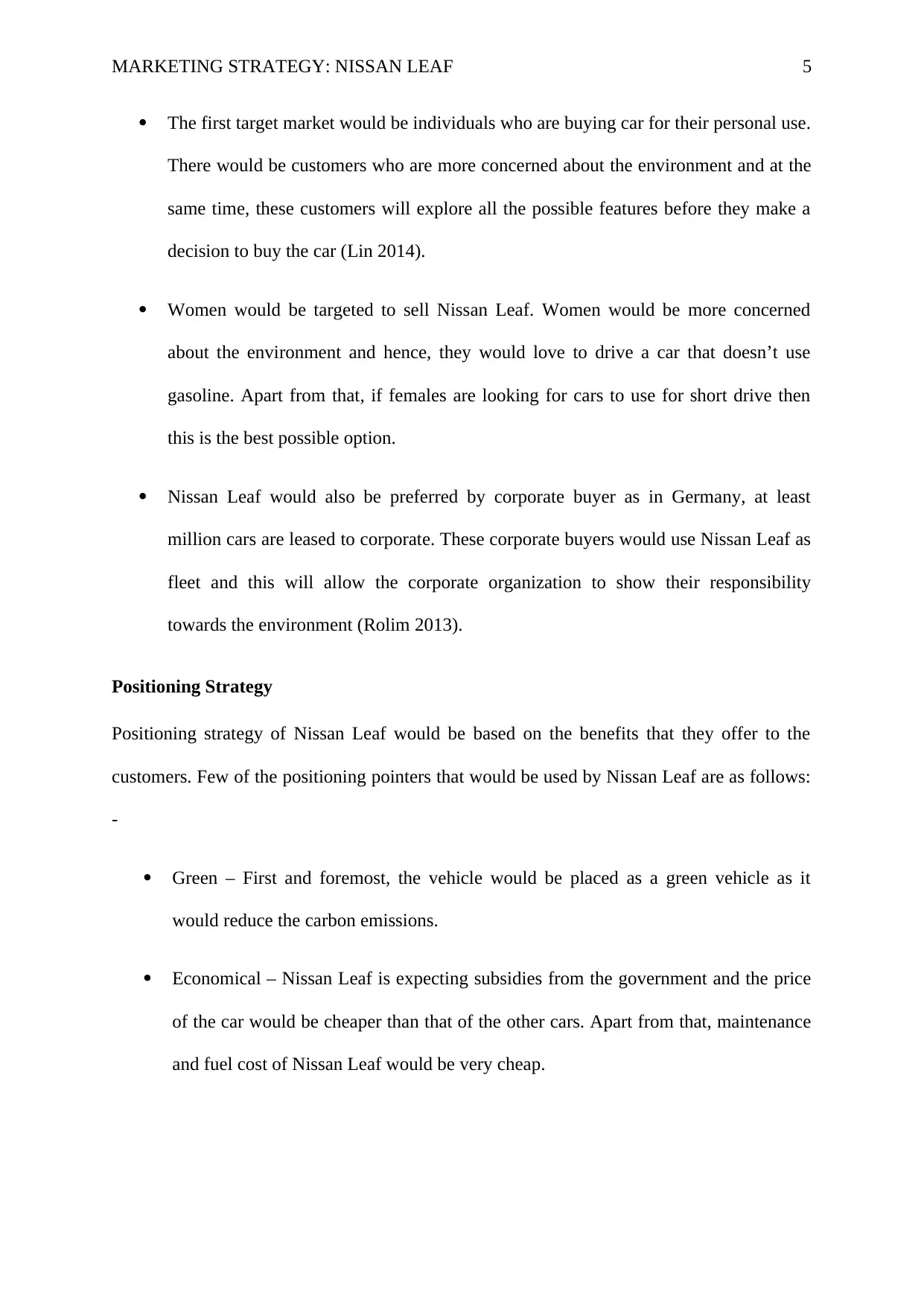
MARKETING STRATEGY: NISSAN LEAF 5
The first target market would be individuals who are buying car for their personal use.
There would be customers who are more concerned about the environment and at the
same time, these customers will explore all the possible features before they make a
decision to buy the car (Lin 2014).
Women would be targeted to sell Nissan Leaf. Women would be more concerned
about the environment and hence, they would love to drive a car that doesn’t use
gasoline. Apart from that, if females are looking for cars to use for short drive then
this is the best possible option.
Nissan Leaf would also be preferred by corporate buyer as in Germany, at least
million cars are leased to corporate. These corporate buyers would use Nissan Leaf as
fleet and this will allow the corporate organization to show their responsibility
towards the environment (Rolim 2013).
Positioning Strategy
Positioning strategy of Nissan Leaf would be based on the benefits that they offer to the
customers. Few of the positioning pointers that would be used by Nissan Leaf are as follows:
-
Green – First and foremost, the vehicle would be placed as a green vehicle as it
would reduce the carbon emissions.
Economical – Nissan Leaf is expecting subsidies from the government and the price
of the car would be cheaper than that of the other cars. Apart from that, maintenance
and fuel cost of Nissan Leaf would be very cheap.
The first target market would be individuals who are buying car for their personal use.
There would be customers who are more concerned about the environment and at the
same time, these customers will explore all the possible features before they make a
decision to buy the car (Lin 2014).
Women would be targeted to sell Nissan Leaf. Women would be more concerned
about the environment and hence, they would love to drive a car that doesn’t use
gasoline. Apart from that, if females are looking for cars to use for short drive then
this is the best possible option.
Nissan Leaf would also be preferred by corporate buyer as in Germany, at least
million cars are leased to corporate. These corporate buyers would use Nissan Leaf as
fleet and this will allow the corporate organization to show their responsibility
towards the environment (Rolim 2013).
Positioning Strategy
Positioning strategy of Nissan Leaf would be based on the benefits that they offer to the
customers. Few of the positioning pointers that would be used by Nissan Leaf are as follows:
-
Green – First and foremost, the vehicle would be placed as a green vehicle as it
would reduce the carbon emissions.
Economical – Nissan Leaf is expecting subsidies from the government and the price
of the car would be cheaper than that of the other cars. Apart from that, maintenance
and fuel cost of Nissan Leaf would be very cheap.
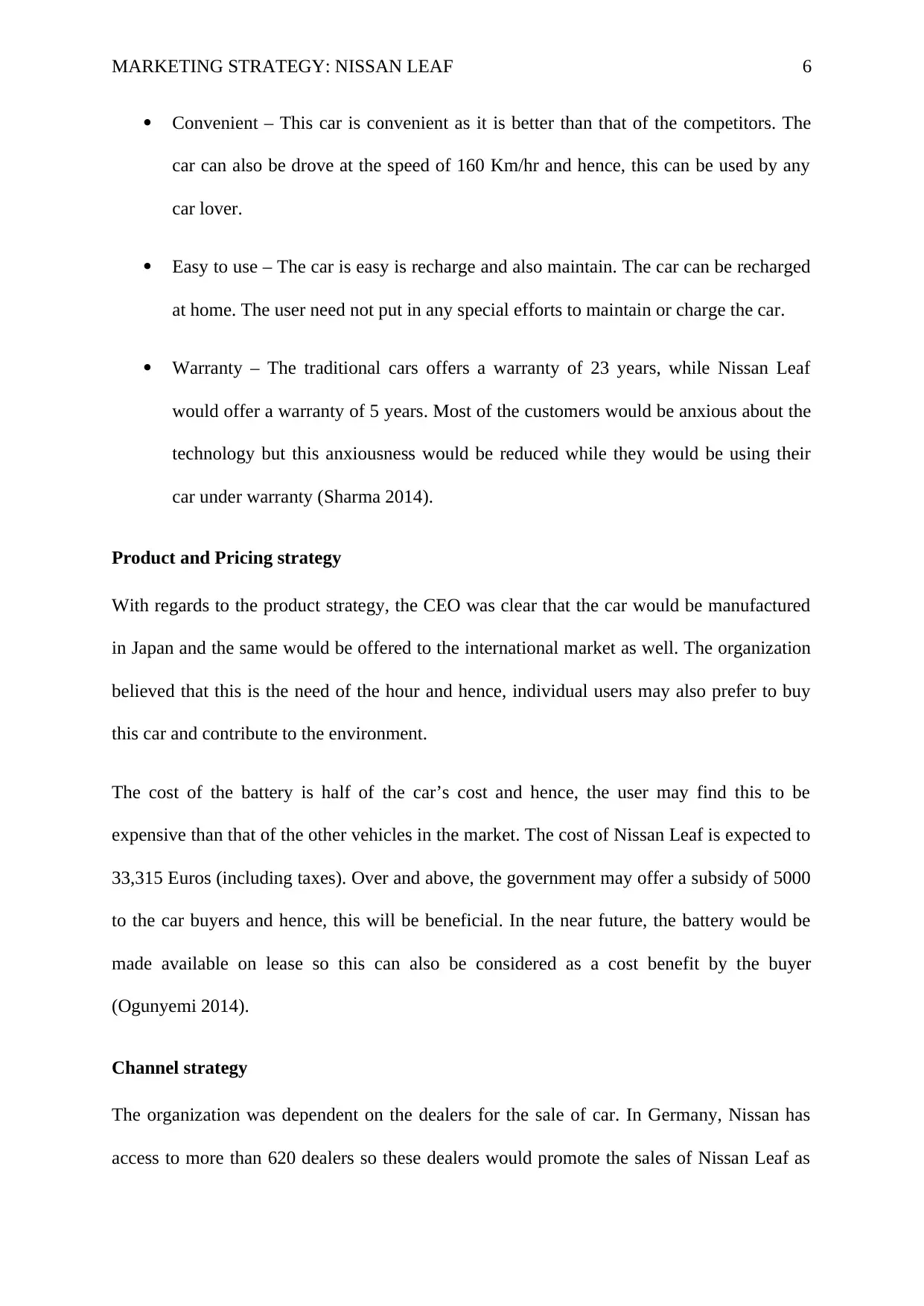
MARKETING STRATEGY: NISSAN LEAF 6
Convenient – This car is convenient as it is better than that of the competitors. The
car can also be drove at the speed of 160 Km/hr and hence, this can be used by any
car lover.
Easy to use – The car is easy is recharge and also maintain. The car can be recharged
at home. The user need not put in any special efforts to maintain or charge the car.
Warranty – The traditional cars offers a warranty of 23 years, while Nissan Leaf
would offer a warranty of 5 years. Most of the customers would be anxious about the
technology but this anxiousness would be reduced while they would be using their
car under warranty (Sharma 2014).
Product and Pricing strategy
With regards to the product strategy, the CEO was clear that the car would be manufactured
in Japan and the same would be offered to the international market as well. The organization
believed that this is the need of the hour and hence, individual users may also prefer to buy
this car and contribute to the environment.
The cost of the battery is half of the car’s cost and hence, the user may find this to be
expensive than that of the other vehicles in the market. The cost of Nissan Leaf is expected to
33,315 Euros (including taxes). Over and above, the government may offer a subsidy of 5000
to the car buyers and hence, this will be beneficial. In the near future, the battery would be
made available on lease so this can also be considered as a cost benefit by the buyer
(Ogunyemi 2014).
Channel strategy
The organization was dependent on the dealers for the sale of car. In Germany, Nissan has
access to more than 620 dealers so these dealers would promote the sales of Nissan Leaf as
Convenient – This car is convenient as it is better than that of the competitors. The
car can also be drove at the speed of 160 Km/hr and hence, this can be used by any
car lover.
Easy to use – The car is easy is recharge and also maintain. The car can be recharged
at home. The user need not put in any special efforts to maintain or charge the car.
Warranty – The traditional cars offers a warranty of 23 years, while Nissan Leaf
would offer a warranty of 5 years. Most of the customers would be anxious about the
technology but this anxiousness would be reduced while they would be using their
car under warranty (Sharma 2014).
Product and Pricing strategy
With regards to the product strategy, the CEO was clear that the car would be manufactured
in Japan and the same would be offered to the international market as well. The organization
believed that this is the need of the hour and hence, individual users may also prefer to buy
this car and contribute to the environment.
The cost of the battery is half of the car’s cost and hence, the user may find this to be
expensive than that of the other vehicles in the market. The cost of Nissan Leaf is expected to
33,315 Euros (including taxes). Over and above, the government may offer a subsidy of 5000
to the car buyers and hence, this will be beneficial. In the near future, the battery would be
made available on lease so this can also be considered as a cost benefit by the buyer
(Ogunyemi 2014).
Channel strategy
The organization was dependent on the dealers for the sale of car. In Germany, Nissan has
access to more than 620 dealers so these dealers would promote the sales of Nissan Leaf as
⊘ This is a preview!⊘
Do you want full access?
Subscribe today to unlock all pages.

Trusted by 1+ million students worldwide
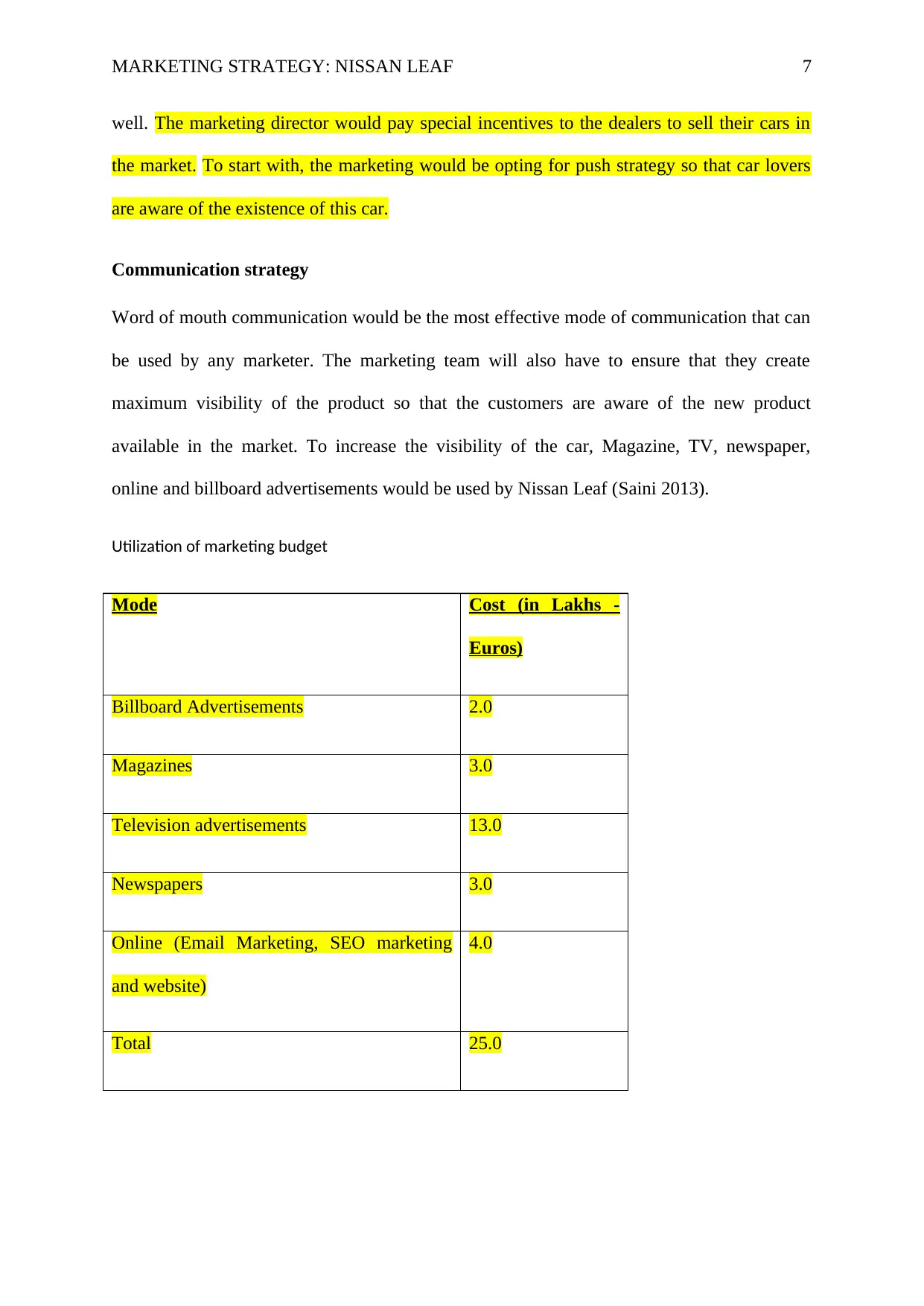
MARKETING STRATEGY: NISSAN LEAF 7
well. The marketing director would pay special incentives to the dealers to sell their cars in
the market. To start with, the marketing would be opting for push strategy so that car lovers
are aware of the existence of this car.
Communication strategy
Word of mouth communication would be the most effective mode of communication that can
be used by any marketer. The marketing team will also have to ensure that they create
maximum visibility of the product so that the customers are aware of the new product
available in the market. To increase the visibility of the car, Magazine, TV, newspaper,
online and billboard advertisements would be used by Nissan Leaf (Saini 2013).
Utilization of marketing budget
Mode Cost (in Lakhs -
Euros)
Billboard Advertisements 2.0
Magazines 3.0
Television advertisements 13.0
Newspapers 3.0
Online (Email Marketing, SEO marketing
and website)
4.0
Total 25.0
well. The marketing director would pay special incentives to the dealers to sell their cars in
the market. To start with, the marketing would be opting for push strategy so that car lovers
are aware of the existence of this car.
Communication strategy
Word of mouth communication would be the most effective mode of communication that can
be used by any marketer. The marketing team will also have to ensure that they create
maximum visibility of the product so that the customers are aware of the new product
available in the market. To increase the visibility of the car, Magazine, TV, newspaper,
online and billboard advertisements would be used by Nissan Leaf (Saini 2013).
Utilization of marketing budget
Mode Cost (in Lakhs -
Euros)
Billboard Advertisements 2.0
Magazines 3.0
Television advertisements 13.0
Newspapers 3.0
Online (Email Marketing, SEO marketing
and website)
4.0
Total 25.0
Paraphrase This Document
Need a fresh take? Get an instant paraphrase of this document with our AI Paraphraser
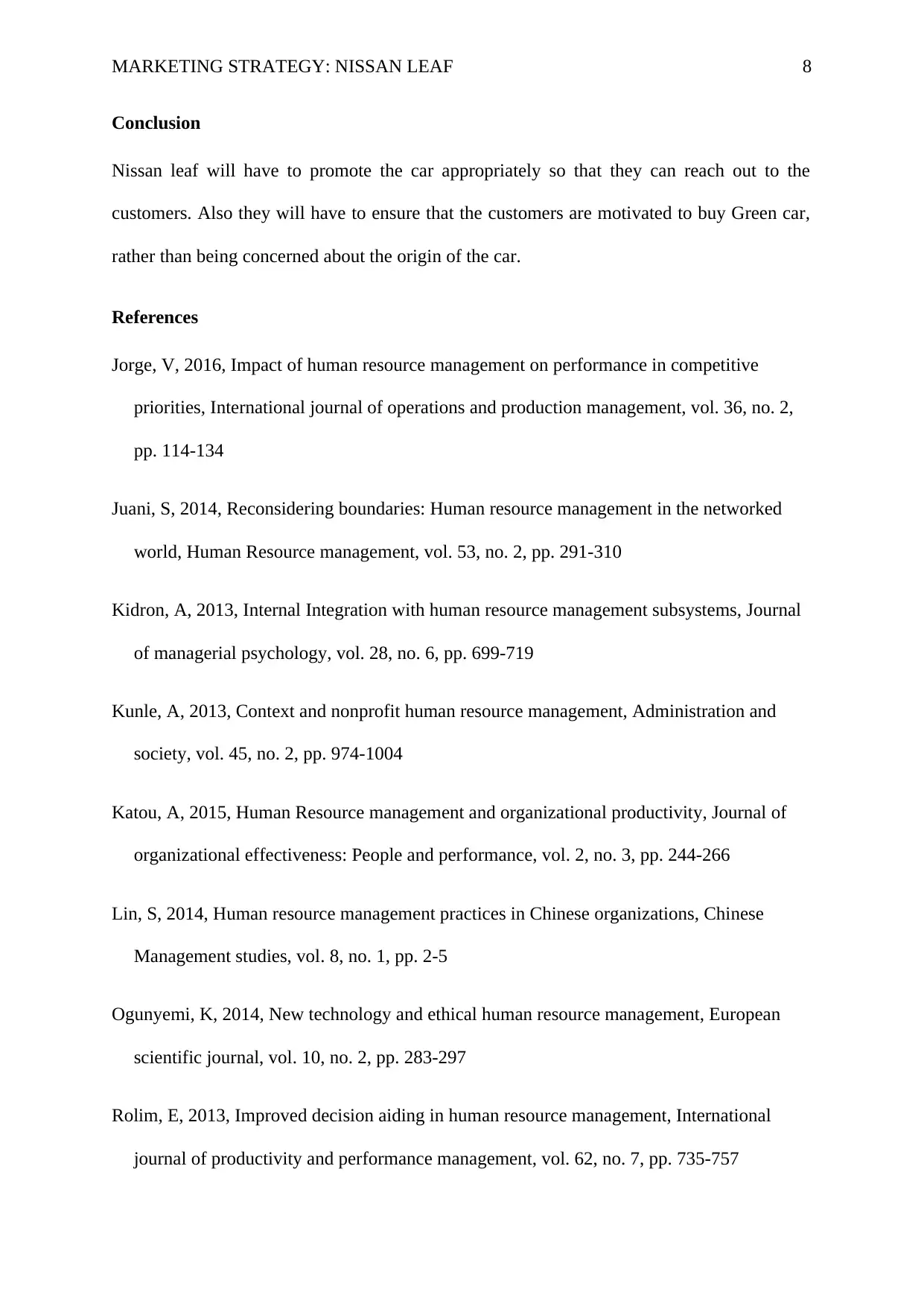
MARKETING STRATEGY: NISSAN LEAF 8
Conclusion
Nissan leaf will have to promote the car appropriately so that they can reach out to the
customers. Also they will have to ensure that the customers are motivated to buy Green car,
rather than being concerned about the origin of the car.
References
Jorge, V, 2016, Impact of human resource management on performance in competitive
priorities, International journal of operations and production management, vol. 36, no. 2,
pp. 114-134
Juani, S, 2014, Reconsidering boundaries: Human resource management in the networked
world, Human Resource management, vol. 53, no. 2, pp. 291-310
Kidron, A, 2013, Internal Integration with human resource management subsystems, Journal
of managerial psychology, vol. 28, no. 6, pp. 699-719
Kunle, A, 2013, Context and nonprofit human resource management, Administration and
society, vol. 45, no. 2, pp. 974-1004
Katou, A, 2015, Human Resource management and organizational productivity, Journal of
organizational effectiveness: People and performance, vol. 2, no. 3, pp. 244-266
Lin, S, 2014, Human resource management practices in Chinese organizations, Chinese
Management studies, vol. 8, no. 1, pp. 2-5
Ogunyemi, K, 2014, New technology and ethical human resource management, European
scientific journal, vol. 10, no. 2, pp. 283-297
Rolim, E, 2013, Improved decision aiding in human resource management, International
journal of productivity and performance management, vol. 62, no. 7, pp. 735-757
Conclusion
Nissan leaf will have to promote the car appropriately so that they can reach out to the
customers. Also they will have to ensure that the customers are motivated to buy Green car,
rather than being concerned about the origin of the car.
References
Jorge, V, 2016, Impact of human resource management on performance in competitive
priorities, International journal of operations and production management, vol. 36, no. 2,
pp. 114-134
Juani, S, 2014, Reconsidering boundaries: Human resource management in the networked
world, Human Resource management, vol. 53, no. 2, pp. 291-310
Kidron, A, 2013, Internal Integration with human resource management subsystems, Journal
of managerial psychology, vol. 28, no. 6, pp. 699-719
Kunle, A, 2013, Context and nonprofit human resource management, Administration and
society, vol. 45, no. 2, pp. 974-1004
Katou, A, 2015, Human Resource management and organizational productivity, Journal of
organizational effectiveness: People and performance, vol. 2, no. 3, pp. 244-266
Lin, S, 2014, Human resource management practices in Chinese organizations, Chinese
Management studies, vol. 8, no. 1, pp. 2-5
Ogunyemi, K, 2014, New technology and ethical human resource management, European
scientific journal, vol. 10, no. 2, pp. 283-297
Rolim, E, 2013, Improved decision aiding in human resource management, International
journal of productivity and performance management, vol. 62, no. 7, pp. 735-757

MARKETING STRATEGY: NISSAN LEAF 9
Saini, D, 2013, Human Resource management, Vision: The journal of business perspective,
vol. 17, no. 1, pp. 98-108
Sharma, S, 2014, Human resource management and trade unions, International journal of
trade, economics and finance, vol. 5, no. 1, pp. 88-92
Saini, D, 2013, Human Resource management, Vision: The journal of business perspective,
vol. 17, no. 1, pp. 98-108
Sharma, S, 2014, Human resource management and trade unions, International journal of
trade, economics and finance, vol. 5, no. 1, pp. 88-92
⊘ This is a preview!⊘
Do you want full access?
Subscribe today to unlock all pages.

Trusted by 1+ million students worldwide
1 out of 9
Related Documents
Your All-in-One AI-Powered Toolkit for Academic Success.
+13062052269
info@desklib.com
Available 24*7 on WhatsApp / Email
![[object Object]](/_next/static/media/star-bottom.7253800d.svg)
Unlock your academic potential
Copyright © 2020–2025 A2Z Services. All Rights Reserved. Developed and managed by ZUCOL.




